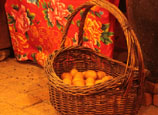
Foie gras is pan-seared in the French way, but with a modern touch of raw oysters and seaweed in a bit of Japanese Dashi soup. The taste is balanced and the liver cannot be overpowered.
The outside of the foie gras, sprinkled with lemon jam, is crispy, sweet-and-sour, which contrasts with the succulent inside. Savory Dashi soup adds more flavors to the buttery liver.
Raw egg is combined with a mixture of pureed foie gras, sea crab and carrot, and then steamed and served hot.
Chef Masami achieves balanced flavor with layers, starting with the sweet and umami crab, followed by delicate egg flavor and then a rich aftertaste of fatty foie gras.
It's also used to make dessert and foie gras creme brulee is classic.
Some Chinese chefs prepare foie gras with traditional Chinese techniques.
Chef Du Caiqing at Hyatt on the Bund marinates foie gras in Shaoxing wine with snow peas. Wine cuts the fattiness of the liver while crispy peas add textural contrast to the smoothy foie gras.
Japanese chefs use foie gras for diversity. "But the exotic food is mostly used in side dishes so it doesn't overpower Japanese flavors that are comparatively mild," says Honda Masami, executive chef of Nadaman Restaurant in Pudong Shangri-La, East Shanghai.
Though foie gras dishes are different, chefs follow some common rules. Chefs use sweet fruit or vegetable with some acidity to cut the fatty sensation and create balance, says Fernando Corona, head chef at Oceans in Banyan Tree Shanghai On The Bund.


















 'Collective children's weddings' held in kindergarten
'Collective children's weddings' held in kindergarten


![]()
